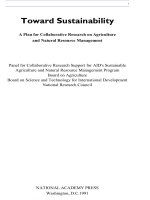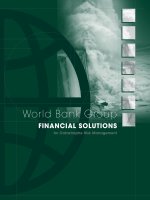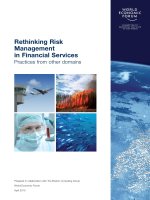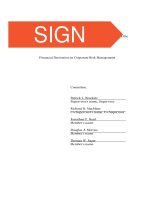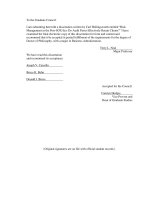Research " Financial Derivatives in Corporate Risk Management " potx
Bạn đang xem bản rút gọn của tài liệu. Xem và tải ngay bản đầy đủ của tài liệu tại đây (454.47 KB, 151 trang )
The Dissertation Committee for Mulong Wang Certifies that this is the
approved version of the following dissertation:
Financial Derivatives in Corporate Risk Management
Committee:
Patrick L. Brockett
Supervisor’s name, Supervisor
Richard D. MacMinn
Co-Supervisor’s name, Co-Supervisor
Jonathan F. Bard
Member’s name
Douglas J. Morrice
Member’s name
Thomas W. Sager
Member’s name
Financial Derivatives in Corporate Risk Management
by
Mulong Wang, B.S.
Dissertation
Presented to the Faculty of the Graduate School of
the University of Texas at Austin
in Partial Fulfillment
of the Requirements
for the Degree of
Doctor of Philosophy
The University of Texas at Austin
August 2001
UMI Number: 3036610
________________________________________________________
UMI Microform 3036610
Copyright 2002 by ProQuest Information and Learning Company.
All rights reserved. This microform edition is protected against
unauthorized copying under Title 17, United States Code.
____________________________________________________________
ProQuest Information and Learning Company
300 North Zeeb Road
PO Box 1346
Ann Arbor, MI 48106-1346
Dedicated to Helen,
My wife
Acknowledgements
I want to thank all those kind people who advised or helped my
dissertation research.
I am greatly indebted to my supervisors, Drs. Patrick Brockett
and Richard MacMinn. This dissertation would not have been finished
without their kind guidance, discussion, and encouragements. It has
been an extremely valuable experience to study and work under their
supervision.
I also would like to thank my dear wife, Helen. With her
consistent encouragements and help, I can dedicate to this research.
Drs. Jonathan Bard, Douglas Morrice and Thomas Sager
provided numerous comments on this dissertation. Their service on
my dissertation committee is greatly appreciated.
Colleagues in Center of Risk Management and Insurance and
Center of Management and Operations for Logistics also provided a lot
of help in my PhD student career. Their discussions inspired a lot of
this dissertation research and other research projects.
v
Financial Derivatives in Corporate Risk Management
Publication No.
Mulong Wang, Ph.D.
The University of Texas at Austin, 2001
Supervisors: Patrick L. Brockett and Richard D. MacMinn
This dissertation addresses how the weather derivative hedges
the corporate risk, how to price the indexed derivative as an exotic
derivative instrument, and the implications of basis risk embedded in
the weather derivative.
The traditional one-dimension financial market framework is
expanded to include the weather index. Under this expanded
framework, the stock market values of the unhedged and hedged
firms are studied first. This provides the base to investigate the
pricing formula for weather derivative under the expanded framework.
It is found that both financial and actuarial approaches are integrated
vi
to price the weather derivative.
A positive risk management paradigm must provide the criteria
to choose the optimal hedging instrument(s) for separable risks. This
dissertation provides the criteria to choose optimal hedging contract
set to hedge the weather risk, under different corporate leverage
levels. It has been found that weather derivative outperforms the
traditional commodity forward in most of the scenarios. When
corporate leverage levels increase, the positive role of the weather
derivative or the commodity forward diminishes.
Basis risk arises by introducing the standard weather index,
and providing the industry-standard payment when the weather
derivative is exercised. The implication of basis risk is investigated
under the same expanded framework. It is found that in most of the
scenarios, basis risk is innocuous.
vii
TABLE OF CONTENTS
Chapter I. Introduction…………………………………………………1
1.1 Background……………………………………………….2
1.2 Literature on Risk and Risk Management………….7
1.3 The Frontier of Risk Management ………………….11
1.4 Weather Risk and Weather Derivatives ……………13
Chapter II. Weather Derivative and Its Valuation……………….17
2.1 Introduction…………………………………………………17
2.2 Basic Model …………………………………………………28
2.3 Valuation of Weather Derivative……………………… 38
Chapter III. Weather Derivative and Commodity Forward…… 48
3.1 Scenario sets…………………………………………………49
3.2 Optimal Hedging…… …………………………………….58
Chapter IV. Basis Risk and Its Implications……………………….86
4.1 Introduction………………………………………………….86
4.2 Implications of Basis Risk…………………………………89
viii
Appendix I. Figures ………………………………………………………106
Appendix II. Extensions of Principle of Increasing Uncertainty…125
Reference…………………………………………………………………….135
Vita……………………………………………………………………………142
ix
Chapter I
Introduction
This dissertation addresses how the weather derivative hedges
the corporate risk, how to price the indexed derivative as an exotic
derivative instrument, and the implications of basis risk. These topics
are summarized in an expanded uncertainty model. Under this
framework, different hedging instruments for studying the optimal
hedging portfolios are compared.
In economics and finance literature, risk has been a subject of
interest and study in many fields including management science,
decision science, and psychology. With the new risks being
continuously discovered, innovative strategies and tools were created
to manage them or transfer them. In this chapter, the background of
risk creation, identification and the importance of risk management
are discussed first. In the second chapter, the economic and financial
literature on risk and risk management, most of which concentrates
on the mechanism of financial derivatives to hedge the risk, or
insurance contract to transfer the individual risk or corporate risk, is
reviewed. The third chapter studies the new frontier of risk
management strategies and tools. In the last part, the weather
1
derivative is introduced as an example of novel risk management tool.
The focus of this dissertation is to study how the weather derivative
hedges the specific risk and its positive effects on creating value for
the hedged firms. The valuation of the indexed derivative was
investigated and the comparison of different hedging instruments in
the corporate finance framework was made, to investigate the optimal
hedging strategies under the presence of separable risks.
This dissertation investigated the pricing problem of the
weather derivative. In addition, the comparison of the weather
derivative and the commodity forward under different corporate
leverage scenarios was made. Finally, the implications of basis risk
were discussed.
1.1 Background
In general, risk is the uncertainty in the future, and has been
traditionally separated into two categories: pure risk or speculative
risk. A pure risk is a chance of loss or no loss, and a speculative risk
is characterized as a chance of loss or gain. An example of pure risk is
catastrophe risk, such as an earthquake, flood or hurricane.
Gambling is an example of speculative risk, which may yield a gain or
2
loss in the end.
In the economics and finance literature, the definitions of pure
risk and speculative risk differentiate insurance from finance. Much of
the insurance literature has concentrated on the management of pure
risk and much of the finance literature on risk management has
concentrated on the management of speculative risk. However, recent
applications of risk management have blurred the line between these
fields. For example, the Catastrophe (CAT) Bond, created to hedge the
catastrophic event risk, is an example of securitization, seen mostly in
the mortgage market. However, the separation between insurance and
finance paradigms was blurred by the creation of the CAT bond. Like
investing in traditional bonds, i.e., Treasury bonds or corporate
bonds, investors bear the speculative risk. The cedent, paying the
premium to the safe trust, obtains the protection as traditional
insurance provides. Therefore, CAT bond is not only an investment
vehicle for the investors, but also a hedging vehicle for the cedents,
which represents a vehicle combining both pure risk and speculative
risk. With the discovery of new risks, new hedging instruments will be
developed to further blur the line of pure risk and speculative risk,
making the distinction between insurance and finance even more
3
ambiguous.
Nowadays, the risk-management process is becoming an
increasingly important financial area for virtually all corporations.
With the dramatically growing costs of losses from different risk
sources, business firms can gain a competitive cost advantage
through the development of a set of cost-effective and efficient risk-
management strategies. The advantages of a well-managed risk
management program include not only a lower total loss cost and an
improved business bottom line, but also an increased predictability of
future losses and cost, which ensures greater budget control and
reduced ambiguity for future net revenue stream. A less risky
corporate operation and payoff preserve more value for the risk-averse
investors and therefore are preferred. In addition, a good risk
management program will immunize the corporation from the sharp
loss in the lower tail of the loss distribution curve [c.f. Stulz (1996)].
Another advantage for an efficient risk management program may be
a lower cost of employment, since workers are more willing to be
employed in a financially stable firm with a lower wage than work in a
risky firm. In summary, an efficient risk management program will
not only reduce the level of losses incurred by a firm, but it will also
4
help the firm improve its financial performance and employee morale.
From a corporate finance perspective, risk management is
becoming a more important field. For instance, during 1990, U.S.
domestic firms spent more than $600
1
billion on projects related to
risk management, such as product liability, workers’ compensation,
employee health, dental, disability and pension benefits, and other
insurance- related products. Research has disclosed that firms
typically pay approximately 40% of their payroll costs on risk
management activities with health care and employee benefits alone,
which account to approximately 26% of the cash flow of a typical firm.
For instance, General Motors Corp. spent more than $4 billion on
health care costs for its employees and is now attempting to cut the
costs by transferring some of it to employees. Recently, large jury
verdicts awarding compensations to customers or employees of
business have skyrocketed, making risk management even more
important for businesses. These types of costs of uncontrolled risk
can, and have, bankrupted corporations while clearly focusing other
corporations on the importance of managing and controlling their own
5
1
See George Rejad’s Principle of Risk Management and Insurance.
risks.
An integral part of managing risk is to transfer the financial
impacts of such risks to another party, if possible, or if the transfer is
not too expensive. Historically, a common mechanism for such
transfers is to use the insurance industry to retain these transferred
risks, by assuming the insurance companies are risk neutral.
Theoretically, the law of large numbers, which states that as the
number of independent and identically distributed risks becomes
arbitrarily large, the standard deviation of the average loss
distribution converges toward zero, makes the insurance industry
viable and profitable. In fact, apart from government regulation,
insurance may still be the single most important mechanism for
regulating risk and safety in society, though many alternative risk-
transferring vehicles have been introduced and implemented recently.
Risk management and insurance costs and protection are also
important for individual consumers. Individuals traditionally
purchase automobile, homeowners, and other insurance to stabilize
their financial conditions, and prepare for uncontrollable risks such
as accidents, death or illness.
6
1.2 Literature on Risk and Risk Management
In the economics and finance literature, risk and risk
management have drawn considerable attention. One of the major
instruments to manage risk is insurance. At the corporate level, the
role and impact of using insurance to transfer risk have been studied
extensively [c.f. MacMinn (1987a); Mayers and Smith (1987); MacMinn
(1989); Garven and MacMinn (1993), MacMinn (1999)]. Insurance is
an efficient instrument to manage the pure risk [c.f. MacMinn (1999)],
and preserves corporate value when there is a probability of
insolvency. At the individual level, the demand for insurance in an
investor’s optimal portfolio was also investigated [c.f. Doherty (1981);
Doherty (1984); Doherty and Schlesinger (1983a); Doherty and
Schlesinger (1983b); Mayers and Smith (1982); Mayers and Smith
(1983)]. In general, insurance has been demonstrated to be an
indispensable risk-management instrument. It was found that
insurance should be included in the optimal investment portfolio
when pure risk is present.
The role that insurance plays in financial markets can be
explained by distinguishing between risks. The finance paradigm
7
characterizes risk as systematic or non-systematic, or equivalently,
diversifiable or non-diversifiable. The insurance paradigm, however,
classifies risks as either pure or speculative. The different definition of
risk separated finance from insurance literatures. For a long time,
finance and insurance were separated because of this line, and the
convergence of hedging by financial instruments and insurance
contracts was largely ignored.
The main purpose of risk management is to preserve or create
values by selecting optimal contract sets. For firms, corporate value is
preserved by the inclusion of hedging instruments in the financial
contracts. For individual investors, more expected utility is created by
the inclusion of insurance and/or other hedging contracts in the
investment portfolio. Before the demise of the Glass-Steagall Act in
the 1990s, insurance and finance industries were treated separately.
Recent mergers, particularly the merger between Citicorp and
Travelers, represent the convergence of finance and insurance in
practice. These new acts and mergers changed the conditions and
more risk management instruments are combined with insurance and
financial techniques.
It is not hard to follow the convergence trend. The main
8
function of financial markets is to efficiently allocate the risk and
facilitate the redistribution of risk. The development of financial
markets has been benefited from the better understanding of
separable risks. When the risk becomes more transparent, it
facilitates the redistribution process in the financial market.
Insurance contract is a subset of financial contracts. If the
combination of insurance and financial hedging contracts creates
more value for the firm, it is preferred. The recent convergence in the
finance and insurance industries enhances the main function of risk
management, that is, by efficiently combining risk management
techniques, more value is created. The development of catastrophe
bond is a good example of the convergence of financial and insurance
techniques. By tapping the pure catastrophic risk into the financial
market, a better allocation of risk and resource is achieved between
firms and investors. Consequently, more value is generated.
Therefore, there is a need to extend the current economics and
finance paradigms to better understand how the financial
instruments can hedge the risk and allow an efficient allocation of
risk bearing and resources. Based on the extended paradigms, further
studies on how to combine the different hedging instruments to reach
9
the optimal allocation of risks and resources can then be made.
A robust model to incorporate and compare different hedging
instruments has not yet been developed in the literature. A better
understanding of risks and risk comparisons is needed, though a
perspective for comparing risks has been provided [c.f., Rothschild
and Stiglitz (1970)]. The process of risk being generated and valued
must also be well understood to compare different hedging
instruments. The optimal hedging contract set can then be chosen to
preserve the most value.
The recent developments of risk management instruments and
financial markets reveal the continued separation of risks so that
each can be redistributed at the least cost to society. To understand
this behavior, more fundamental notions and understanding of risks
are required. A robust model is needed to allow the risks to be valued
separately and so the choices for an optimal hedging contract set can
be made.
10
1.3 The Frontier of Risk Management
With the convergence of finance and insurance, many new risk
management tools were developed. Alternative Risk Transfer (ART) is
one subset of them. With the rapid identification and separation of
new risks, many of the ART solutions are tailored to specific client
problems and offer integrated risk management solutions, for
instance, a multi-year or multi-trigger cover. ART solutions focus on
increasing the efficiency of the risk transfer, broadening the coverage
of insurable risks and tapping the capital markets for additional
capacity. These risk management solutions make it easier for a
company to efficiently manage those risks from which it gains no
comparative advantage in managing itself. The development of ART is
consistent with the objective of an efficient risk- management solution
by allowing institutional clients to allocate more capital to their core
businesses, thereby generating higher returns.
Over the last few years, ART solutions have expanded rapidly.
The initial focus is on captives. Such solutions will allow companies to
deal with high-frequency risks in a more cost-efficient way than
through traditional industrial insurance. Since 1980s, captives have
been increasingly used as a financing instrument for some low-
11
frequent, but high-severity risks which could not be placed in the
traditional ways. Despite the continuous erosion of tax benefits and
the persistently low premium rates in the traditional market during
the 1990s, captives are set to come into their own as holistic risk
management tools.
The potential for the sustained growth of new risk management
strategies and tools is considerable. Captive is one example. Other
new instruments have been created and implemented. Attempts to
transfer insurable risks directly to capital market investors have
received special attention over the past a few years. This can be
through the securitization of risks in the form of insurance bonds or
via derivative transactions. In this way, the policyholder obtains
additional capacity without incurring any credit risk, in particular, for
the catastrophe losses, while investors are able to further diversify
their investment portfolios with the invention of new instruments
such as CAT bonds.
The rapid development of risk management instruments must
be based on a widely acceptable economic and/or financial
mechanism for the instruments to efficiently hedge the risks. For
instance, weather derivatives may be a good example to hedge the
12
weather-related risks. To tap the capacity of financial markets, a
widely understandable pricing formula and the positive role of adding
weather derivative into the optimal contract set of the firm must be
investigated. In addition, the advantages and disadvantages of using
those new hedging instruments must also be understood for them to
be widely implemented and traded.
1.4 Weather Risk and Weather Derivatives
As different as they may be, the business and production
processes of utility companies, theme parks, fashion houses, ice-
cream manufacturers, building companies and sports goods
manufacturers, all have one thing in common: their business success
is highly dependent on prevailing weather conditions. Nearly everyone
talks about the weather but few do anything about it. Virtually all
sectors of the economy are directly or indirectly subject to the
influence of the weather in some form or other. For instance, daily
beer consumption can be increased if the temperature rises. Weather
risks are important to the energy and power supply industry because
their product price is highly sensitive to the spot weather conditions.
The agriculture industry is another example. Production level is highly
13
correlated with weather conditions, which affects profit.
Unusual weather patterns have increasingly prompted
companies whose results are affected by the prevailing weather
conditions to seek protections against effects of this kind. An
unusually warm winter may cut the revenue figure of a natural gas
company, but an unusually cold winter may sharply increase the
demand of natural gas.
Hedging weather risks not only will yield a more predictable
revenue stream, but also increase the shareholder’s value. The energy
and power sectors may benefit most from the new tools to hedge
weather-related risks, with other hedging instruments including
weather derivatives in the firm’s portfolio will stabilize the net revenue
stream and reduce the loss of revenue in the lower tail of the weather-
risk distribution.
A weather derivative is an exotic derivative because the
underlying asset is not negotiable or traded. It is based on the
weather index, such as Cool Degree Days or Heating Degree Days,
which influence the volume of the goods, particularly the energy
products, traded in the market. Therefore, the major effect of weather
derivatives is to hedge the volume risk, instead of the price risk. For
14
instance, a warmer-than-average winter season may drive the natural
gas demand lower, thus a weather put
2
option will be in the money
and will provide compensations to the option buyer, since the weather
index (HDD in this case) is below the strike value.
The notion behind a weather hedge is that the results of
weather-sensitive sectors can be subject to great volatility, even if
prices remain unchanged, due to a change in demand or volume.
An important, but unresolved issue is a unanimous pricing
formula for the weather derivative. This prevents the weather
derivative from being traded efficiently in the market. The underlying
asset is not traded and the traditional Black-Sholes model cannot be
applied. In addition, the assumption of the log-normal distribution of
the weather index, such as CDD or HDD, is difficult to verify due to
the lack of a robust empirical test and consideration of seasonal
change. To solve this issue, the dynamism of the weather (trends) and
the actuarial weather forecast information must be included in the
pricing model to best reflect the value of weather derivatives.
In general, risk is a commodity that may be produced,
exchanged or preserved. The way in which businesses and society
15
2
A put option will be in the money when the index is below the strike value. In the
assess, control and transfer risk has been examined extensively and
with the invention of new risk management tools being studied
continuously. This dissertation is an attempt to examine how weather
derivatives are incorporated into the corporate contract sets, how to
price the indexed derivatives, and the implications of the basis risk.
The Appendix is an expansion of the uncertainty model [c.f., MacMinn
and Holtmann (1983)], including more stochastic inputs, to examine
whether the widely cited Principle of Increasing Uncertainty (PIU) may
still hold in this extended model. Chapter two discusses the inclusion
of the weather derivative into the firm’s hedging contract set and
valuation of the weather derivative. Chapter three delineates several
scenarios based on corporate-leverage levels. For each scenario, the
impacts of different hedging strategies on the corporate value are
studied. In chapter four, implications for the corporate payoff and
corporate value are studied when the basis risk is present.
16
warmer winter, the HDD index will be lower, since less heating is needed.

